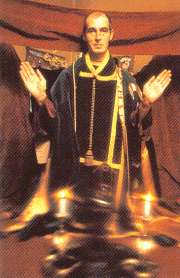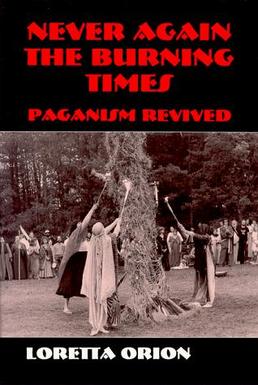Related Research Articles

Gardnerian Wicca, or Gardnerian witchcraft, is a tradition in the neopagan religion of Wicca, whose members can trace initiatory descent from Gerald Gardner. The tradition is itself named after Gardner (1884–1964), a British civil servant and amateur scholar of magic. The term "Gardnerian" was probably coined by the founder of Cochranian Witchcraft, Robert Cochrane in the 1950s or 60s, who himself left that tradition to found his own.

Skyclad refers to ritual nudity in Wicca and Modern Paganism. Some groups, or Traditions, perform most or all of their rituals skyclad. Whilst nudity and the practice of witchcraft have long been associated in the visual arts, this contemporary ritual nudity is typically attributed to either the influence of Gerald Gardner or to a passage from Charles Godfrey Leland's 1899 book Aradia, or the Gospel of the Witches, and as such is mainly attributed to the Gardnerian and Aradian covens.

Wicca, also known as "The Craft", is a modern pagan, syncretic, earth-centered religion. Scholars of religion categorize it as both a new religious movement and as part of occultist Western esotericism. It was developed in England during the first half of the 20th century and was introduced to the public in 1954 by Gerald Gardner, a retired British civil servant. Wicca draws upon a diverse set of ancient pagan and 20th-century hermetic motifs for its theological structure and ritual practices.

A Book of Shadows is a book containing religious text and instructions for magical rituals found within the Neopagan religion of Wicca. Since its conception in the 1970s, it has made its way into many pagan practices and paths. The most famous Book of Shadows was created by the pioneering Wiccan Gerald Gardner sometime in the late 1940s or early 1950s, and which he utilised first in his Bricket Wood coven and then in other covens which he founded in following decades. The Book of Shadows is also used by other Wiccan traditions, such as Alexandrian Wicca and Mohsianism, and with the rise of books teaching people how to begin following non-initiatory Wicca in the 1970s onward, the idea of the Book of Shadows was then further propagated amongst solitary practitioners unconnected to earlier, initiatory traditions.
Dorothy Clutterbuck, was a wealthy Englishwoman who was named by Gerald Gardner as a leading member of the New Forest coven, a group of pagan Witches into which Gardner claimed to have been initiated in 1939. She has therefore become a figure of some significance in the history of Wicca.
Alexandrian Wicca or Alexandrian Witchcraft is a tradition of the Neopagan religion of Wicca, founded by Alex Sanders who, with his wife Maxine Sanders, established the tradition in the United Kingdom in the 1960s. Alexandrian Wicca is similar in many ways to Gardnerian Wicca, and receives regular mention in books on Wicca as one of the religion's most widely recognized traditions.

Doreen Edith Dominy Valiente was an English Wiccan who was responsible for writing much of the early religious liturgy within the tradition of Gardnerian Wicca. An author and poet, she also published five books dealing with Wicca and related esoteric subjects.
Frank Stewart Farrar was an English screenwriter, novelist and prominent figure in the Neopagan religion of Wicca, which he devoted much of his later life to propagating with the aid of his seventh wife, Janet Farrar, and then his friend Gavin Bone as well. A devout communist in early life, he worked as a reporter for such newspapers as the Soviet Weekly and the Daily Worker, and also served in the British army during the Second World War. He was responsible for writing episodes for such television series as Dr. Finlay's Casebook, Armchair Theatre and Crossroads, and for his work in writing radio scripts won a Writer's Guild Award. He also published a string of novels, written in such disparate genres as crime, romance and fantasy.

The New Forest coven were an alleged group of pagan witches who met around the area of the New Forest in southern England during the early 20th century. According to his own claims, in September 1939, a British occultist named Gerald Gardner was initiated into the coven and subsequently used its beliefs and practices as a basis from which he formed the tradition of Gardnerian Wicca. Gardner described some of his experiences with the coven in his published books Witchcraft Today (1954) and The Meaning of Witchcraft (1959) although on the whole revealed little about it, saying he was respecting the privacy of its members. Meanwhile, another occultist, Louis Wilkinson, corroborated Gardner's claims by revealing in an interview with the writer Francis X. King that he too had encountered the coven and expanded on some of the information that Gardner had provided about them. According to Gardner, the faith they followed was the Witch-Cult, a supposed pagan religion that had survived in secret after the Christianization of Europe. This was in keeping with the now-discredited theories of Margaret Murray and her supporters.

Janet Farrar is a British teacher and author of books on Wicca and Neopaganism. Along with her two husbands, Stewart Farrar and Gavin Bone, she has published "some of the most influential books on modern Witchcraft to date". According to George Knowles, "some seventy five percent of Wiccans both in the Republic and Northern Ireland can trace their roots back to the Farrars."

Alex Sanders, born Orrell Alexander Carter, who went under the craft name Verbius, was an English occultist and High Priest in the modern Pagan religion of Wicca, responsible for founding, and later developing with Maxine Sanders, the tradition of Alexandrian Wicca, also called Alexandrian Witchcraft, during the 1960s.

What Witches Do is a book by Stewart Farrar, and is an eye-witness account of Wiccan practices, namely that of the Alexandrian coven run by Alex Sanders and his wife Maxine Sanders.
Eleanor "Ray" Bone who also went under the craft name Artemis, was an influential figure in the neopagan religion of Wicca. She claimed to have been initiated in 1941 by a couple of hereditary witches in Cumbria. She later met and became friends with Gerald Gardner, and was initiated into Wicca, becoming the High Priestess in one of his covens. She was a friend of several important figures in Wicca during the modern Witchcraft revival, including "Dafo", Jack Bracelin, Patricia Crowther, Doreen Valiente and Idries Shah. Bone was a close confidant of Gardner's initiator Dafo, and she reported that the New Forest coven was a hereditary coven that followed the old ways of the Hampshire region, and that they traced their origins to the time of the death of King William Rufus in the Norman era.
The history of Wicca documents the rise of the Neopagan religion of Wicca and related witchcraft-based Neopagan religions. Wicca originated in the early 20th century, when it developed amongst secretive covens in England who were basing their religious beliefs and practices upon what they read of the historical witch-cult in the works of such writers as Margaret Murray. It also is based on the beliefs from the magic that Gerald Gardner saw when he was in India. It was subsequently founded in the 1950s by Gardner, who claimed to have been initiated into the Craft – as Wicca is often known – by the New Forest coven in 1939. Gardner's form of Wicca, the Gardnerian tradition, was spread by both him and his followers like the High Priestesses Doreen Valiente, Patricia Crowther and Eleanor Bone into other parts of the British Isles, and also into other, predominantly English-speaking, countries across the world. In the 1960s, new figures arose in Britain who popularized their own forms of the religion, including Robert Cochrane, Sybil Leek and Alex Sanders, and organizations began to be formed to propagate it, such as the Witchcraft Research Association. It was during this decade that the faith was transported to the United States, where it was further adapted into new traditions such as Feri, 1734 and Dianic Wicca in the ensuing decades, and where organizations such as the Covenant of the Goddess were formed.

In the neopagan religion of Wicca a range of magical tools are used in ritual practice. Each of these tools has different uses and associations and are commonly used at an altar, inside a magic circle.

Vivianne Crowley is an author, university lecturer, psychologist, and a High Priestess and teacher of the Wiccan religion.

Neopagan witchcraft, sometimes referred to as The Craft, is an umbrella term for some neo-pagan traditions that include the attempted practice of magic. These traditions began in the mid-20th century, and many were influenced by the witch-cult hypothesis; a now-rejected theory that persecuted witches in Europe had actually been followers of a surviving pagan religion. The largest and most influential of these movements was Wicca. Some other groups and movements self-describe as "Traditional Witchcraft" in an effort to distinguish themselves from Wicca.
In Modern English, the term Wicca refers to Wicca, the religion of contemporary Pagan witchcraft. It is used within the Pagan community under competing definitions. One refers to the entirety of the Pagan Witchcraft movement, while the other refers explicitly to traditions included in what is now called British Traditional Wicca.

Enchanted Feminism: The Reclaiming Witches of San Francisco is an anthropological study of the Reclaiming Wiccan community of San Francisco. It was written by the Scandinavian theologian Jone Salomonsen of the California State University, Northridge and first published in 2002 by the Routledge.

Never Again the Burning Times: Paganism Revisited is an anthropological study of the Wiccan and wider Pagan community in the United States. It was written by the American anthropologist Loretta Orion and published by Waveland Press in 1995.
References
Footnotes
- ↑ Hutton 1999, p. 324-332.
- 1 2 3 4 Hutton 1999, p. 324.
- ↑ Sanders 1976, p. 14-35.
- ↑ Ruickbie 2004, p. 141-2.
- ↑ Ruickbie 2004, p. 142.
- ↑ Parker 1993.
- 1 2 3 Sanders 2008.
- ↑ Howard 2009, p. 208.
- ↑ Farrar 1973.
- ↑ Howard 2009, p. 217.
- ↑ Sanders 2008, p. 166-169.
- ↑ Sanders 2008, Chapter 15.
- ↑ A C Towner Ltd (funeral directors) handwritten entry in Volume dated 16 June '86 - 9 Nov '88.
- ↑ Hastings Cemetery and Crematorium, Register of Cremations, Volume 19, Cremation Record 47733
- ↑ See "Maxine Sanders Web Site Diary entry" . Retrieved 2017-01-26.,.
Sources
- Deutch, Richard (1977). The Ecstatic Mother: Portrait of Maxine Sanders, Witch Queen. Bachman and Turner. ISBN 0-85974-048-X.
- Drury, Neville (2003). Magic & Witchcraft: From Shamanism to the Technopagans. Thames & Hudson Ltd. ISBN 0-500-28514-4.
- Farrar, Stewart (1973). What Witches Do: The modern coven revealed. Sphere Books. ISBN 0-7221-3449-5.
- Howard, Michael (2009). Modern Wicca: A History from Gerald Gardner to the Present. Llewellyn. ISBN 978-0-7387-1588-9.
- Hutton, Ronald (1999). The Triumph of the Moon: A History of Modern Pagan Witchcraft. Oxford University Press. ISBN 0-19-285449-6.
- Jordan, Michael (1996). Witches: An Encyclopedia of Paganism and Magic. London: Kyle Cathie Limited. ISBN 1-85626-193-X.
- Kemp, Anthony (1993). Witchcraft and Paganism Today. Brockhampton Press. ISBN 1-86019-127-4.
- Parker, J (1993). At the Heart of Darkness. Pan.
- Ruickbie, Leo (2004). Witchcraft out of the Shadows: A Complete History. Robert Hale. ISBN 0-7090-7567-7.
- Sanders, Maxine (1976). Maxine: The Witch Queen. Wyndham Publications Ltd. ISBN 0-352-39738-1.
- Sanders, Maxine (2008). Firechild: The Life and Magic of Maxine Sanders "Witch Queen". Mandrake of Oxford, Ltd. ISBN 978-1-869928-97-1.
